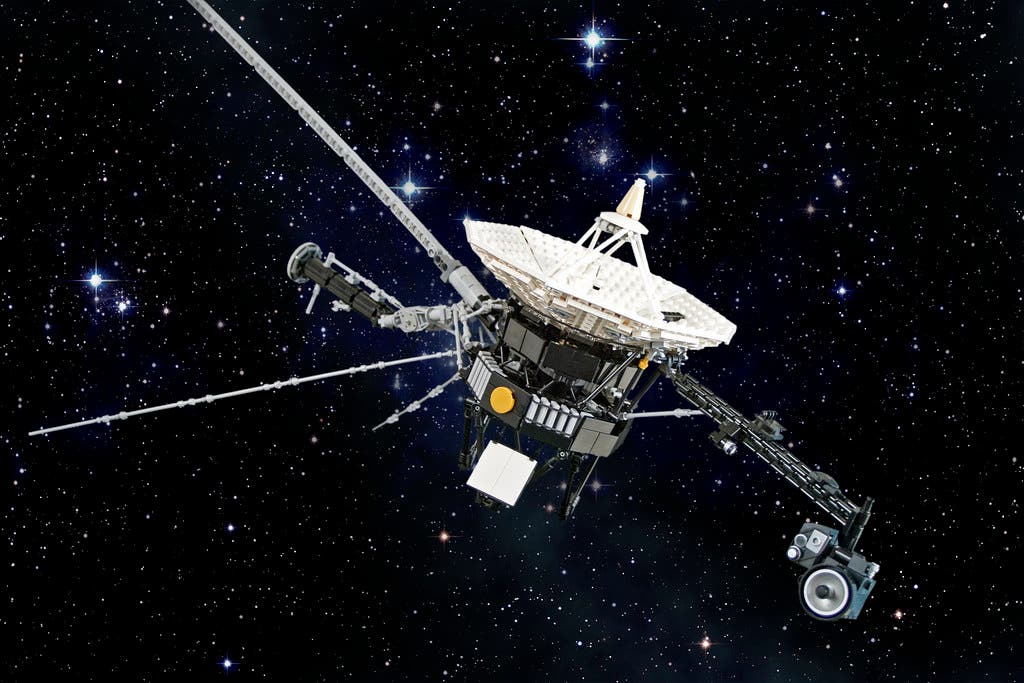Today marks the 45th anniversary of the launch of Voyager 1, one of our most iconic space explorers and the single, farthest-from-Earth man-made object in history.

Back in 1977, Voyager 1 and 2 launched, a couple of weeks between them, from Cape Canaveral, Florida. At the time of their launch, each of the car-sized probes was to visit and take photographs of the giant gas planets in our Solar System. Their 12-foot antennae would beam these images back for the world to wonder at. After showing us Jupiter, Saturn, Uranus, and Neptune, as well as their moons, in incredible detail by the end of 1989, this mission was complete. In 1990, Voyager 1 turned around and took the infamous Pale Blue Dot photograph of Earth.
Since then, the Voyagers have traveled over 10 billion miles away from our planet, and have long since left the solar system. Befitting its title as the farthest-away man-made object, Voyager 1 is carrying the Golden Records, two golden phonograph records that carry sounds from our planet, a map on how to get here, and pictures of life on Earth — including humans.
Now, 45 years after their launch, the venerable probes still maintain some working instruments — four on Voyager 1 and five on Voyager 2. With these, they are sending back a wealth of information from interstellar space pertaining to magnetic field strength, plasma density, as well as the direction and strength of the interstellar winds they are travelling through.
Venerable explorers
“The purpose of the interstellar mission is to measure the sun’s effects as we go further and further from Earth. We’re trying to find out how the sun’s heliosphere interacts with interstellar space,” says Suzanne Dodd, project manager of the Voyager interstellar mission at JPL.
But the Voyagers’ unwritten mission has also been to meet any alien life that might be out there and inform them that humanity is peering into the stars — and where to find us. Each of the Golden Records looks like a vinyl disk but made of metal, and pack music, sound recordings of nature, voice messages, photos, and other samples of humanity and Earth. Each probe also packed appropriate players for the disks and instructions on how these are to be used. According to members of the team that designed these records, their purpose was to answer the very same questions that humans would have, should they meet any alien race.
It is possible that the Golden Records will not be not found for a long time, perhaps even after humanity has gone extinct. As such, they are not meant as an invitation so much as a testament of what humanity is, a star-borne piece of evidence that we’ve existed and of what we’ve done, imprinted on metal.
The Voyagers’ legacy does live on on Earth, as well. Their success has inspired NASA and other space agencies around the world to send follow-up visits to planets such as Jupiter and Saturn, as well as their moons. These missions include Galileo, Juno, Cassini, and the European Space Agency’s Huygens lander. New probes aimed at these planets are also under construction, such as the Europa Clipper, Dragonfly, or ESA’s JUICE.
Perhaps one of the most impressive elements of the Voyagers’ story is that they lasted far, far longer than they were intended — and they are still operational and transmitting data. They are so far into their mission currently that their signals take around 22 hours to reach us.
Eventually, however, even they will go dark. The nuclear power generation systems that keep the probes running will ultimately run out of fuel. Even today, they are operating at reduced capacity, generating 4 less watts per year, and ground control has shut down some non-essential systems and heaters in some operational sensors to add a few more years to the crafts’ life expectancy. All things considered, ground control believes the probes will function for a few years, a decade more, at best.
But even without power, the probes will continue carrying the Golden Records, humanity’s message in a bottle, into the great beyond.
And while some far-flung alien race might discover this well after humanity has disappeared, sci-fi fans can also envision a different future: one in which our descendants catch up to these Voyagers, and archeologists of the future get the chance to learn about us from these hardy machines.









